Hey hey, this Sunday it’s Mother’s Day here in North America and to honour that, I figured that a look at a painting of a mother and child would fit the bill nicely. And what better artist than Mary Cassatt? The theme of mother and child was a big one for Cassatt – many paintings exist of that subject done in both pastel and oil. The majority of these paintings show the relationship between a mother and her child in as many positions as you can imagine. However, you’ll find fewer works by Mary Cassatt of a mother with her children.
This painting, “After the Bath,” is a favourite of mine.

What do I love about it? Here’s the start of a list:
- I love Cassatt’s brave use of bright green in the background and the girl’s bright orange outfit whereas the rest of the painting is way more muted if similar in value.
- I also love the feeling of comfort between the mother and her children.
- I love the way the painting seems to be more about the relationship between the two children than with their mother.
- Here, as always, I find much to appreciate in the loose almost-unfinished and spontaneous look of Cassatt’s work.
Let’s have a closer look at this painting.
First, the hands of the children, the girl grasping the arm of who we assume is her brother. Look at the way Cassatt doesn’t delineate each finger. The light hits the girl’s fingers as they curl around his arm. There’s a sense of shadow indicated by a couple of blue marks that hardly seem to be in the correct place. The boy’s hand is clenched – we can see that and yet on close examination, it just seems to be a bunch of random marks. All of this tends to suggest movement, a very short moment in time barely captured.

The two children are physically linked and it seems they are looking at each other. Their mother, on the other hand, appears to look beyond her son. She appears to almost be in a daydream, comfortable with her children but with other things on her mind.

The girl’s head, caught at a tilted angle, and barely seen, looks at her brother. There are a few hatched lines in her hair showing what? A bow? A hairclip? I love that it really doesn’t matter. Those lines speak enough to say something, that there’s some ornamentation in her hair.

The young boy gazes at his sister. His hair, tousled and beautifully rendered with a few swipes and strokes of pastel, echoes the yellow and orange colours in his sister’s outfit, yet again tying them together visually.

Speaking of orange and squiggles, check out the seemingly haphazard marks in the what-looks-like-fur of the daughter’s collar. Can you see how they tell us something but without detail??

I’m always keen to see the hand of the artist at work and overjoyed when I discover some of the underdrawing still visible in a piece. You can easily see signs of Cassatt’s charcoal drawing in this detail. See how she drew the mother’s arm beneath the clothing? And you can also see the original outline of the girl’s clothing.

There’s a lot of green in the upper part of this painting. Can you see how Cassatt brought the colour down into the lower section?
Also evident in this closeup is Cassatt’s tendency to leave areas unfinished. According to the Met’s website, this decision was based on the concept of the nonfini (the “unfinished”), a device that was a frequent practice by one of her mentors, Édouard Manet.

Although much care is given to the heads, the same isn’t true of much of the rest of the painting. Have a look at the lines and colours in this detail. A chaos of marks! Yet you can easily make out the folds in the white towel, the transparency of the sleeve, an embroidered lemon perhaps. All rather vague and yet adding just enough to share something of the story of what’s happening here.
This is such a great example of how Cassatt applied broken and unblended strokes that gives such a feeling of spontaneity.

I was curious about what looks like a wood stove. Why would Cassatt include it? Yes, it may have been there, but, as an artist, she had the choice to keep or remove it. I think the darkness behind the girl’s orange outfit grounds the picture by setting off both the brightness and lighter tone of her clothing. It’s barely indicated, merely scribbled in yet, like so much in the piece (and Mary Cassatt’s work in general), it’s enough to let us know what’s there.

The circular shape of the stove also continues the semi-circle started by the towel on the left, continuing through the boy’s shoulders and the children’s linked arms and over to the girl. It helps tie them all together.

One last thing I’ll mention (there’s so much more!) is the vase. Why did Cassatt include it? What purpose does it serve?

And with that, let’s have a look at the painting again.

That was going to be the end of this post. Until I came across another painting. From a private collection (Drs Tobia and Morton Mower), it appears to have been part of an exhibition in the Denver Art Museum.
I was delighted to find it. It’s dated the same year as the painting we’ve just examined – 1901 – and certainly appears to be the same trio of people. It’s almost the same size but seems less finished (as revealed by the unfinished hands) yet, signed as it is, suggests that the artist was finished with it. Look at those gloriously bold marks of blue and white on the right side!!
This painting gives us clues to the pink scribble in the girl’s hair above – it’s a bow here.
I love seeing the differences between the two paintings. Here, the towel is laid out on the mother’s lap. The colours are much more muted. And, all the attention by both females is towards the boy. The feeling is certainly different from the previous piece where it’s so much about the relationship and link between the children.

And now I’d LOVE to hear from you! What are your thoughts about these paintings by Mary Cassatt? Were you surprised about anything I brought to your attention? It would be wonderful to hear your ideas so be sure to leave a comment below!
Until next time,
~ Gail
PS. Back in December 2015 (was it that long ago???), I paid close attention to another pastel by Mary Cassatt called “The Long Gloves.” Curious? Click here.
PPS. I noticed that the words “No 3” are in the title of the second painting. This suggests there’s at least one more version of these three people together in a painting! (I went on a search and wow! Have a look here and here and here.
I then got curious about the Sara in the painting and found this information on Christies website.
Apparently, after 1900, Mary Cassatt chose “to use the same models repeatedly, particularly children from Mesnil-Theribus, Oise, the village near her country home, Beaufresne, fifty miles northwest of Paris. In 1901, she began to frequently employ Sara, the young golden-haired girl…, who according to Adelyn Breeskin, was a granddaughter of one of the former presidents of the French Republic, Emile Loubet. (Mary Cassatt: A Catalogue Raisonné, Washington, D.C., 1970, p. 150) The sweetness of Sara’s face, the ethereality of her features and her reportedly good-natured demeanor made her a favored model for Cassatt during these years, and she was the subject of many of the artist’s works from the period…”
PPPS. Because I was curious, I played around with the painting. I first “painted over” the vase. Then I did the same for the woodstove. What do you think happens to the painting with these changes?



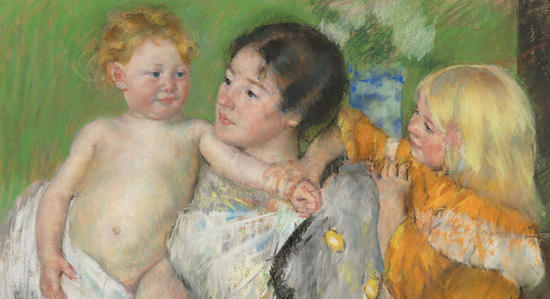





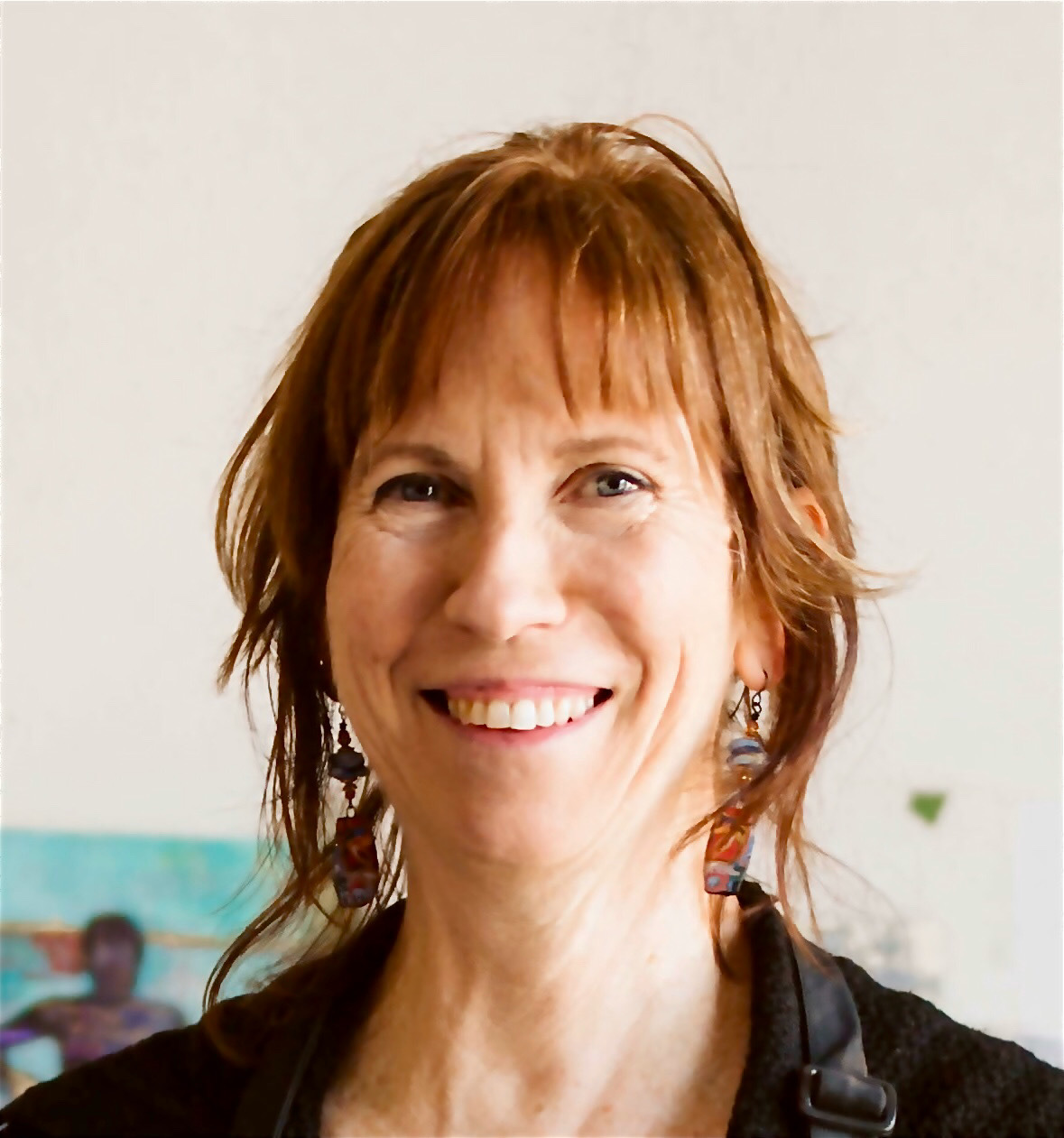



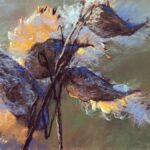
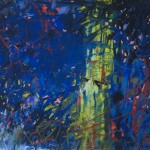

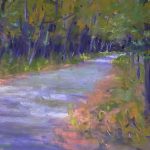






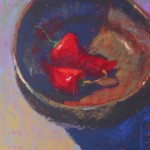


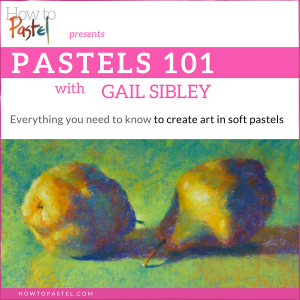

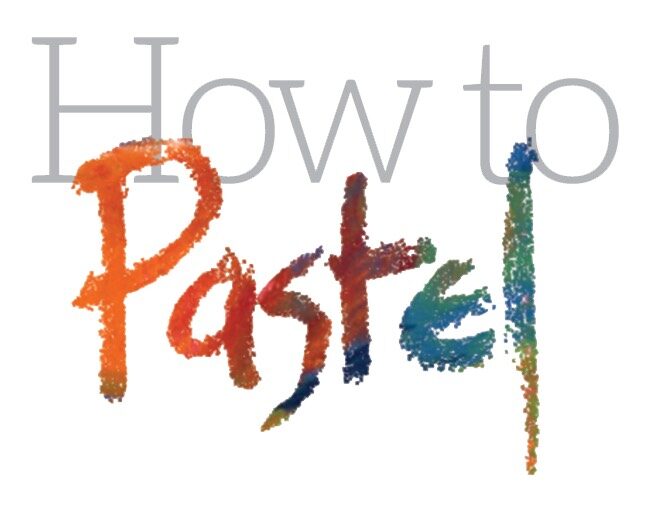

4 thoughts on “Mary Cassatt – After The Bath”
Love Mary Cassatt and your observations of the painting. Although I don’t like the vase in the painting I can see that removing it and the stove, changes (for me) the feel of the painting. It seems to go from a view of an intimate family moment, to a staged portrait. But fun to see what you did.
Also love how Mary Cassatt was comfortable with unfinished and barely there parts of the pastel. Something to be learned there for me. Thx Gail!!!
Thanks so much for chiming in with your thoughts about the vase Debbie! You’re right about intimate portrait vs staged portrait (even though that may have been what it was!). And YES to the way Cassatt was comfortable with leaving parts unfinished with all the “finished” parts being the faces and moving out from there.
Thanks for this lovely walk through the past, and yet so contemporary in its fresh handling. The stove and vase give the painting depth. I just love it, and so admire how Cassatt portrayed relationships so spontaneously. Thanks for this, and your analysis, Gail! She was truly a master.
You are so welcome Joy. And yes to what you’ve said. She really was a master. This is so evident as you examine more and more of her work!